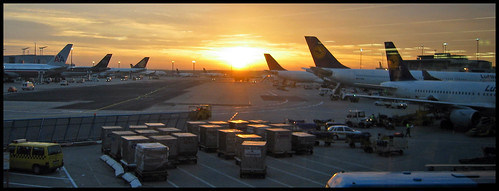Sliding Air Travel Makes for Fewer Delays This Summer; Smoothest summer travel in years for fliers (except for those poor souls who spent 6hrs onboard Continental Express 2816 on the tarmac at Rochester, Minnesota)
(Source: USA Today)
A marked decrease in airline travel has made this summer the smoothest in years for fliers accustomed to lengthy delays and snarled traffic. Overall, it has been a remarkably pleasant summer season for air travelers, who had gotten used to big delays this time of year.
The aviation system is suffering significantly fewer delays than the past two years, according to government data and aviation experts. The lengthiest delays — which cause people to miss connecting flights and trigger the most havoc — are down even more steeply. In May, June and July, delays longer than two hours dropped by more than 25% compared with 2008 and 2007, according to the Federal Aviation Administration (FAA).
The nation’s aviation system is still far from immune to thunderstorms, congestion and unexpected problems: Several jets in recent months were stranded on the ground for hours, prompting angry complaints by passengers. New York’s three airports, which remain more clogged than average, continue to drag down performance across the country, the data show.
Overall, traffic at large airports is down 9% this year compared with last, according to the FAA. Airline restructuring in recent years has been so drastic that airports such as Pittsburgh and St. Louis have seen traffic drop by as much as two-thirds, turning them into veritable airport ghost towns amid the economic downturn. Here are some interesting highlights from the USA Today article.
- There has also been a 9 percent decreaes in overall traffic at large airports, thanks to the high prices of fuel last year and the economic downturn. That trend is expected to continue through Labor Day, when approximately 3.5 percent fewer people are expected to fly compared to last year.
- Cincinnati, which had more than 500,000 arrivals and departures in 2003, is on pace for fewer than 200,000 this year.
- Of the nation’s busiest 31 airports, only two have not improved through June this year compared with a year earlier, according to the federal Bureau of Transportation Statistics. Atlanta’s Hartsfield-Jackson International, one of the few airports that has not seen a significant decline in flights, and Newark Liberty International, plagued by that region’s congestion, saw slight increases in delays, according to the data.
- The biggest improvement in on-time performance occurred at O’Hare. Last year through June, only 61% of flights arrived on time at O’Hare. This year, 78% arrived within 15 minutes of their scheduled arrival times.
Click here to read the entire article.



